Connecting the toilet to the sewer: how to achieve maximum
After completing work on the design of the wastewater disposal system from an apartment or a country cottage, it is necessary to install and connect various plumbing fixtures. For this, some use the services of specialists. But you can do everything yourself, saving, thereby saving money. The question of how to connect the toilet to the sewage with your own hands, and will be the topic of today's article.

Connecting elements
To connect the toilet to the sewer, you must use:
- plastic bends;
- pleated cuffs;
- fun pipes
The last option is the most aesthetic, but when using this type of compound, the following requirements must be observed:
- the fan pipe cannot be cut;
- It is not possible to change the geometric shape of the connecting element.
The most commonly used are two other methods. Before you connect the toilet to the sewer, you should decide what length and configuration will be the connecting element.
Plastic eccentrics can be rotated along its own axis, only slightly compensating for the deviations between the release of the plumbing fixture and the sewer pipe. As for the corrugated pipe, it can be pulled out, rotated and bent in any plane.

Tip! Connecting with a corrugated pipe helps when you do not know how to connect the toilet to the sewer, located at a considerable distance or in a remote place. In addition, it is possible to match holes of different diameter.
Assembling a toilet bowl
Installation of cistern
To connect the bowl and the water tank, two special bolts and a rubber gasket are used, which are put on the drainage device pipe.
The work is done in the following order:
- Washers and rubber seals are strung on the bolts, after which they are inserted into the holes at the bottom of the tank.
- The water tank is installed in place. Carefully ensure that its drain hole is clearly above the same hole in the bowl.
- To fix the structure are plastic nuts with small ears. Tighten them need hands, without the use of special keys.
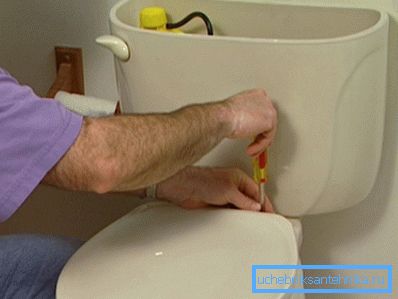
Plumbing connection
This stage should be carried out after fixing the product on the floor and connecting it to the sewer. It is best to buy a flexible hose, equipped with both ends of the nuts. To achieve tightness, it is advisable to use rubber gaskets or special plastic tape (learn here how to close the sewer pipes in the toilet).
The water pipe must be equipped with an additional tap. This allows, if necessary, to block the flow of water without disturbing the usual functioning of other plumbing fixtures.

Connection process
Using corrugations
The installation manual for the toilet contains several simple points:
- One end of the corrugated pipe is inserted into the sewer drain, after which the joint is sealed with silicone.
- The second end of the flutes joins the release of the toilet bowl and is carefully fixed.
- After that you need to check the tightness of the nodes. Pour a bucket of water and pour it into the bowl. Check for water in the joints. If necessary, lubricate problem areas again.
- Use the marker to mark the places where you need to drill for mounting fasteners.
- After removing the sanitary ware in a safe place, drill holes using a perforator. Ensure that the instrument is strictly vertical.
- Insert dowels into the holes.
- Put the toilet and attach it using the supplied or purchased separately accessories.
- Connect the end of the pipe to the drain and seal the connection.
- Once again, check the reliability of connections and the quality of attachment to the floor surface. The product should not stagger when a person sits on it. You may have to additionally make a cement screed under the base.
- The final stage is the sealing of the place where the toilet bowl meets the floor with silicone. This will help prevent the formation of dirt and mold there.
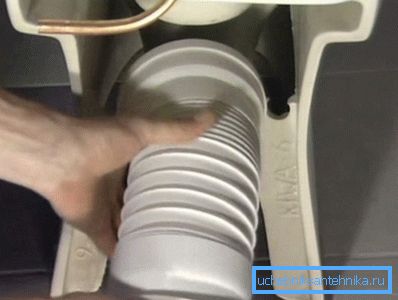
Without corrugated pipe
Consider how to properly connect the toilet to the sewer using special pipes.
In total there are three different drain designs:
- oblique release - were widely distributed earlier, now this kind of practically does not occur;
- vertical release - in this case, the installation of the funnel pipe in the wall should be at an angle of 90 degrees;
- horizontal release - the angle of fastening of this part should be in the range from 30 to 40 degrees.
Tip! Before buying a toilet bowl and (or) connecting pipes, it is necessary to clarify which exhaust system your chosen model is equipped with. In case of inconsistency of types, you will have to re-purchase either the pipes or the product itself.

Features of installation of various systems
Vertical release
Such models of toilet bowls are more common in European countries. In this case, the scheme of connecting the toilet to the sewage system has some peculiarities, since special connections and siphons are already installed in the construction of the sanitary device.
This kind of drain allows you to install a toilet at any angle to the wall.
For convenience, we divide the whole process into several stages:
- The site is marked for installation, after which a special flange is fitted to the floor, equipped with a clamp.
- It is installed sewer pipe.
- Then the installation of the toilet. To do this, a cut of the drain is inserted into the flange and rotated before fixing. This is achieved by a snug fit of the pipe to the cut of the sewer pipe. The tightness of the connection is provided by a rubber gasket.
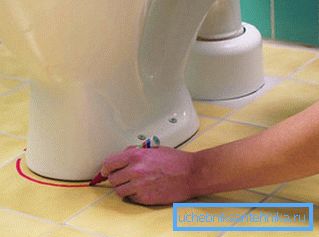
Horizontal release
In this case, a cut of the sewer pipe is in the wall. A similar system is widespread in our country, as the old cast-iron sewers were equipped according to this scheme, and the new plastic ones are mounted according to their model.
You only need to tightly connect the toilet drain to the sewer pipe using a special adapter.
Make sure that the toilet is carefully and securely fixed to the floor. To do this, use special dowels and screws. Do not overtighten the fastener, as this may damage the plumbing device, the price of which is quite high.
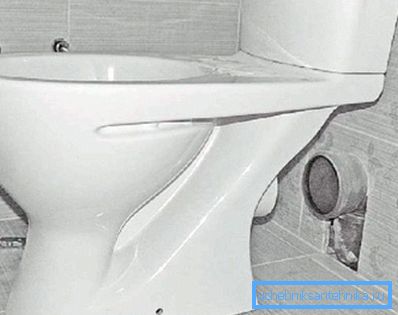
Connecting the toilet to the cast-iron sewage is carried out in a similar way. But in this case it is necessary to additionally use a rubber connecting sleeve, which allows to achieve maximum tightness.
With oblique release
Connecting toilet with an oblique release to the sewer is as follows:
- The outer part of the toilet outlet with the grooves on it should be smeared with red lead mixed with drying oil.
- At the end of the need to wind the sealing resin strand, which additionally coat with red lead.
- The end of the strand is released outside. Otherwise, during installation, it may unwind and contribute to the formation of a blockage at the exit of the toilet.
- Then installation is carried out. It is necessary to insert the socket of the sanitary device directly into the hole of the drain pipe and fix the product on the floor with fixing hardware.
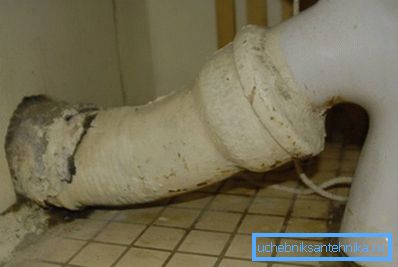
Conclusion
Remember that reliability and quality of functioning of the toilet bowl depend on careful observance of all stages of work. For more information about the installation of plumbing fixtures can be found in the video in this article (also find out where the smell of sewage in the toilet comes from).